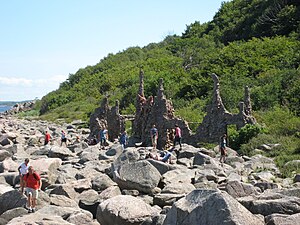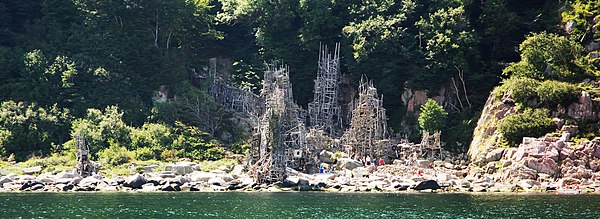Ladonia (micronation)
From Wikipedia, the free encyclopedia
| This article is missing citations or needs footnotes. Please help add inline citations to guard against copyright violations and factual inaccuracies. (October 2007) |
| Ladonia | ||
| Micronation | ||
 [1] [1]Flag |
 Coat of Arms |
|
| Motto: omnia vincit amor (English: Love Conquers All) Anthem: "Two unnamed anthems [2]"by Greve Jan Lothe von Eriksen & Toomas Mathiesen |
||
| Status | Current | |
|---|---|---|
| Area claimed | 1 km2 | |
| Membership | 13628[3] (2008-01-01) | |
| Date of foundation | June 2, 1996 | |
| Leadership | Queen Ywonne I Jarl President Fredrik Axwik (temporary) |
|
| Purported organisational structure | Constitutional monarchy | |
| Language | Phrased Latin[4] | |
|
||
Ladonia (Swedish: Ladonien) is a micronation, proclaimed in 1996 as the result of a years-long court battle between artist Lars Vilks and local authorities over three sculptures. The claimed territory is an enclave of southern Sweden. It contains two sculptures, and was created in protest of Swedish authorities who wished to remove them. Ladonia is not recognized by any other accredited state, and acknowledging international law, there is no legal basis for calling it a state.
Contents |
[edit] History
In 1980, artist Lars Vilks began construction of two sculptures, Nimis (Latin for "too much", a structure made of 75 tonnes of driftwood) and Arx (Latin for "fortress", a structure made of stone), in the Kullaberg nature reserve in north-west Skåne, Sweden. The location of the sculptures is difficult to reach, and as a consequence they were not discovered for two years, at which point the local council decided that the sculptures should be removed. They declared the sculptures to be houses, the building of which was forbidden on the nature reserve.
Vilks appealed the decision of the council, but lost. He appealed repeatedly, and finally the case was settled, in the council's favour, by the Swedish government. However, in the meantime Nimis had been bought from Vilks by the artists Christo and Jeanne-Claude. In 1996 Vilks declared the micronation of Ladonia in protest of the local council.[citation needed]
In 1999, another sculpture, Omphalos (named after Omphalos, a small sculpture in the temple at Delphi, "marking the centre of the world"), was created. It was made of stone and concrete, 1.61 metres high and weighing a tonne. The Gyllenstiernska Krapperup Foundation, formed to promote art and culture, accused Vilks of building this sculpture and complained to the police, and in August 1999 the district court ordered its removal. The Foundation had also demanded the removal of Nimis and Arx, but the court ruled against it. The Foundation appealed this decision to the Supreme Court, who eventually ruled against it. The police were unable to positively identify Vilks as the sculptor, but the district court held that he was.
The removal of Omphalos was itself controversial. Vilks was ordered to find an acceptable way to remove the sculpture. He proposed blowing it up on 2001-12-10, Nobel Day and the 100th Anniversary of the Nobel Prize, and applied to the county council for permission to do so. The county council made a decision on 2001-12-07, but kept it secret until 2001-12-10. By that time, another artist, Ernst Billgren, had bought Omphalos from Vilks, and had requested that it not be damaged. In the early hours of 2001-12-09, a crane boat was sent (by DYKMA, under contract from the Enforcement Administration) to the site and removed the sculpture (at a cost of SEK 92,500, billed to Vilks). Despite the new owner's request, the sculpture was damaged by handling. In response to this, the Enforcement Administration was satirically declared to be "Performance Artist of the Year" in 2002.
Afterwards, Vilks applied to the county council again, this time for permission to erect a memorial in the place that Omphalos had stood. Permission was granted by the council to erect a monument no greater than 8 centimetres high. This was duly done, and the monument was inaugurated on 2002-02-27.
In 2002, Vilks reported that over 3,000 Pakistanis, confused by the micronation's web site, had applied for immigrant status.
In July 2006, a satire web site of "the Armed Coalition Forces of the Internets" (ACFI) declared war on the micronation claiming that the government has not recognized the citizens' rights of internet and piracy.[1]
[edit] Population and citizenry
When it was created, Ladonia had a population of zero. According to the official website: "No-one lives in Ladonia. All of its citizens are nomads." Currently, there are twelve-thousand Ladonian citizens.[2]
Nowadays, Ladonian citizenry comprises many self-styled "ministers" who are predominantly fellow artists around the world who have heard of Vilks. Vilks has specified the "taxation" of Ladonia to be "contributing your creativity". Many of the ministries have artistic connotations and whimsical names.
Some have asserted that, because the Ladonian flag is green, it is a muslim nation. However, no one has ever conducted a census of Ladonian citizens, the assertion is dubious.
[edit] Nimis
Nimis is a series of wooden sculptures situated along the coast in the Kullaberg Nature Reserve, Höganäs Municipality, in the northern part of Skåne County, Sweden. They are a massive, wooden labyrinthine structure connected by several wooden towers, and are said to be mostly constructed from driftwood.
They were begun by the artist Professor Lars Vilks in 1980 and have been the subject of a long-running legal dispute between the Swedish authorities and the artist. As no permission was given to build on the site within the nature reserve, the County Administrative Board in Skåne has sought to have Nimis demolished, despite the fact that it has become a popular tourist attraction.
As Nimis' existence is not sanctioned by the state, it is difficult to find - there are no official sign posts, nor is it marked on maps. It lies a few kilometres northwest of the town of Arild and somewhat farther from the town of Mölle, and can only be reached on foot following a well-worn path with yellow "N"s painted on trees and fences. The path begins as an easy stroll past Himmelstorp, a well-preserved eighteenth-century farmstead, but quickly becomes a steep and rocky climb down to the coast.
[edit] Notes
- ^ "Implode Ladonia". Web site of the Armed Coalition Forces of the Internets. http://implodeladonia.net/. Retrieved on 2006-08-17.
- ^ According to Vilks, interview in Globe Trekker program
[edit] References
- "Omphalos". Moderna Museet. http://www.modernamuseet.se/v4/templates/template3.asp?bhjs=0&lang=Eng&id=2292. Retrieved on July 14 2005.
- "Filippa Kihlborg in Ladonia". http://members.tripod.com/~stanislavs/ladonia/filippa.htm. Retrieved on July 14 2005.
- "Visa for Ladonia". The Power of Culture. 2002-04-03. http://www.powerofculture.nl/uk/current/2002/april.html.
- "Pakistanis' 'new life' in imaginary country". BBC News. 2002-03-11. http://news.bbc.co.uk/1/hi/world/south_asia/1867519.stm.
- TT Spektra (2006-07-03). "Påhittat land fyller tio år" (in Swedish). Svenska Dagbladet. http://svd.se./dynamiskt/kultur/did_13098878.asp.
[edit] External links
| Wikimedia Commons has media related to: Ladonia (micronation) |
- The official Ladonia website
- The Office of Nothingness, which also manages the 1st chamber of the Ladonian Parliament
- The Ministry of Hunting and Game preservation
- The Ministry of Art and Jump
- The Ministry of Undisclosable Purpose
- The passports of the Minister of Duct Tape and High Voltage, the Minister of the Dark Side, the Minister of Holidays, and the Minister of Unnumbered Things.






